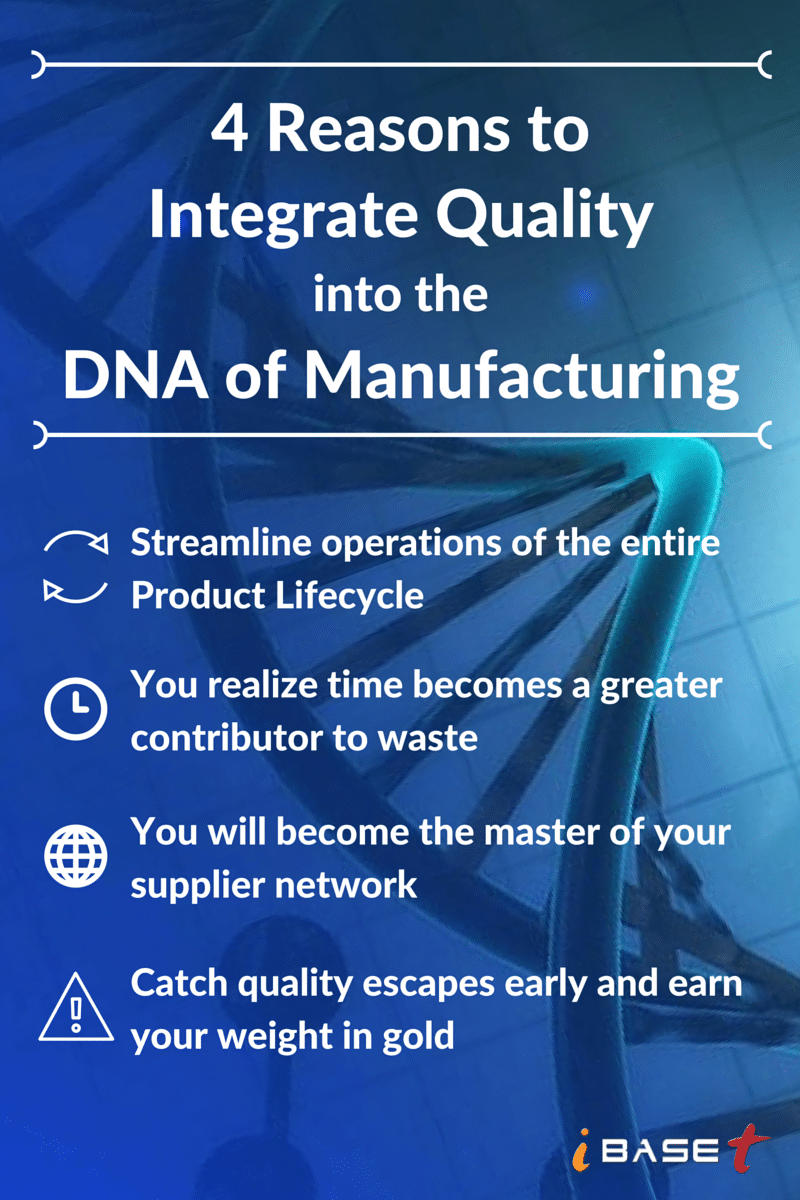 Quality in manufacturing should not just be a cog in the organization chart but a mindset for all members of the organization. Integrate quality throughout each step in the manufacturing process and companies begin moving from being reactive by solely focusing on quality as a separate entity to proactively moving to an Enterprise Quality Management System (EQMS) where quality is built into processes, work instructions, verifications, and even into the supplier network.
Quality in manufacturing should not just be a cog in the organization chart but a mindset for all members of the organization. Integrate quality throughout each step in the manufacturing process and companies begin moving from being reactive by solely focusing on quality as a separate entity to proactively moving to an Enterprise Quality Management System (EQMS) where quality is built into processes, work instructions, verifications, and even into the supplier network.
Below are four reasons why companies must integrate quality further upstream and throughout the entire organization vs. strictly the shop floor:
1. Streamline operations of the ENTIRE product lifecycle, not just the ones you catch and fix
It is nearly impossible for an organization to catch all process inefficiencies without having visibility into the as-built Work in Process. With the use of paper based processes or numerous pinpoint solutions, disparate data becomes hard to correlate inefficiencies or even pinpoint problems in an audit. This leaves quality control to troubleshoot problems only as they erupt on the shop floor, often leaving many other unseen problems untouched which could lead to greater problems down the production line.
Using an EQMS solution to capture all aspects of production including who worked on what, using which tools according to what specifications gives full traceability of work that is being completed and how it is being moved down the production line. Capturing this data along with reporting to this data gives managers throughout the value chain visibility into the entire production line and makes finding inefficiencies much easier. If a product is out of spec you know exactly why with a click of a button because you have full trace genealogy of people, processes and parts.
2. You realize time becomes a greater contributor to waste than you thought.
Most people that are part of profitable organizations ignore the numerous waste drivers in their processes that suck days, weeks, and even months of time out of production. This pain is amplified when revenues slow down and quality missteps begin to adversely affect production lowering throughput and accelerating costs.
By sitting down and monetizing the amount of time that is wasted through miscommunication, scrap and rework, and inefficient processes you begin to realize that most people work unnecessarily longer hours, this could be prevented through better collaboration and process control with enhanced levels of traceability. Taking a lesson from Lean manufacturing, reducing wasted time can yield incredible efficiencies and cost savings.
A customer of ours, an engine manufacturer, performed an ROI assessment of implementing an MES with integrated Enterprise Quality Management. Their and performed an ROI calculation showed that moving to such a system would save their company over $3 million dollars in wasted time on the shop floor, not including other beneficial returns on investment. The bottom line is time is money and quality control pays dividends.
3. You will become the master of your supplier network
A key component of implementing an Enterprise Quality Management System is mandating that your suppliers become part of your overall enforcement of quality throughout the value chain. After all, a product is only as good as the quality put into each aspect throughout the value chain. One weak part can cause the whole product to crumble, especially if certain pieces are designated or associated with mission-critical components.
Enforcing quality amongst your supplier network and having visibility into those quality metrics will help keep suppliers on top of quality control but also gives OEM’s the ability to moderate and change suppliers that are not performing to minimum standards.
4. Catch quality escapes early and earn your weight in gold
Finding errors including non-conformances and discrepancies early on in the manufacturing process can dramatically reduce overall costs. Typically defects that go unfound through a manufacturing lifecycle can increase costs tenfold because of the scrap and rework due to the quality escape. Therefore it benefits manufacturers to find these defects early in the manufacturing lifecycle.
Particularly in highly regulated industries, a quality escape that goes into a final product undetected can also lead to expensive and detrimental recalls. Therefore, integrating quality checks into the process and pushing quality to each active member including those in the supplier network can save the company a lot of time, money, and heartache.
Humans by nature are at the whim of their own hereditary traits. Our DNA is not chosen but given to us at birth. However organizations differ because they can create and mold a company’s culture, giving stakeholders the ability to transform an organizations own DNA.
John Ruskin said it best, “Quality is never an accident; it is always the result of intelligent effort.” Leaders mindful to integrating quality throughout the manufacturing value chain will undoubtedly birth a new generation of superior products to power us into the next generation.
For more information, download our eBook, Five Strategies for Improving Enterprise Quality Management, and discover how complex manufacturers are streamlining their supply chains by making compliance and quality management the core of their business models, emerging stronger than their competitors.
